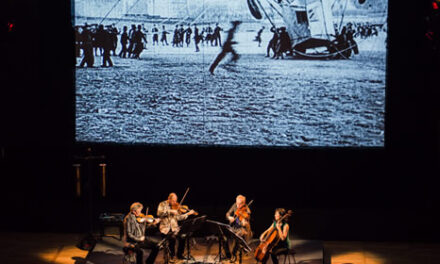The Four Seasons Chamber Music Festival, presented by East Carolina University and artistic director Ara Gregorian, consistently brings quality chamber music performances and workshops to the Triangle, its home in Greenville, and beyond. In its 19th season, the festival is more present in the Triangle now than ever.
Part of the “Classic Series,” the “Chamber Music Monuments” program combined two quintets that loom large in the standard repertoire of clarinet chamber music. Both, inspired by different clarinet virtuosi of Brahms’ and Mozart’s day, showcase the flexibility of the instrument in solo and supporting roles and explore the unique timbre that results when a clarinet is added to a string quartet. Clarinetist Alan Kay, violinist Hye-Jin Kim, violist Maiya Papach, and cellist Michael Kannen joined Gregorian onstage for this performance at Hayes Barton United Methodist Church.
In purposeful non-chronological order, the Brahms Clarinet Quintet in B minor, Op. 115, was first; written late in Brahms’ career, the quintet is full of yearning rubato and a dense texture. In the first movement, the texture is punctuated by bouncy, fierce cadences that showed the unity among the five musicians. The four movements offered lots of juxtaposition in the handling of the clarinet, too – in the first movement, Kay played exploratory arpeggios that laced in and out of the forefront, at times extraordinarily well-blended with the strings.
Like a battle between light and dark, the movements’ final cadences alternated between major and minor, ending finally in the home key of B minor. Regardless of the mode, each cadence’s ending produced a moment of silent reflection in the audience that the quintet harnessed by letting it linger as long as possible. This type of frozen atmosphere is difficult to describe and even trickier to create, but it became an important feature of this concert.
Mozart’s Quintet in A, K.581, for clarinet and strings, features long, melodic lines and delicate figures in each instrument. For either style, the five musicians easily shared each other’s articulation and expression when encountering the same melodic motives. The clarinet was at the forefront with a languid melody that was propelled forward by the strings in an interesting opposition, especially in the Larghetto second movement. Perhaps the most intricate music of the concert came in the fourth movement, where the first violin and cello rapidly traded phrases in a dueling variation. As Gregorian remarked at the beginning of the concert, it made sense to satisfy Brahms’ angst with the conclusion of the Mozart, a rapid, flamboyant coda ending the concert firmly in a joyous A Major.
Four Seasons returns to the capital on Feb. 24, at St. Mary’s. Click here for details.











